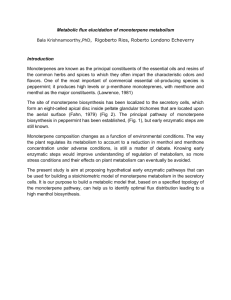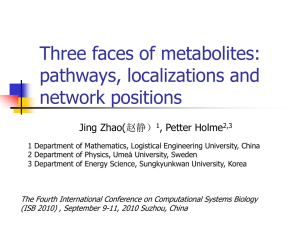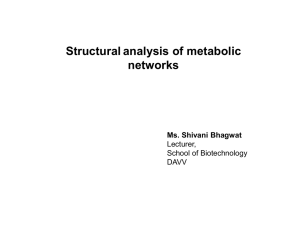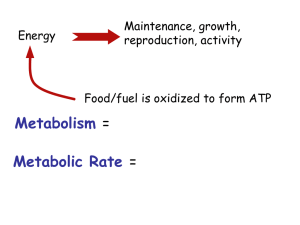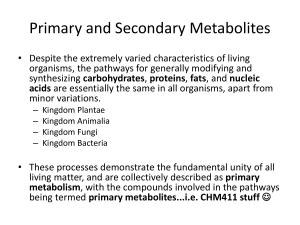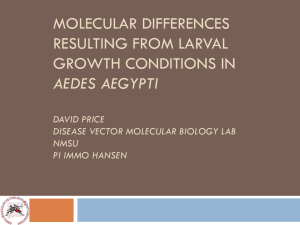Metabolic flux analysis
advertisement
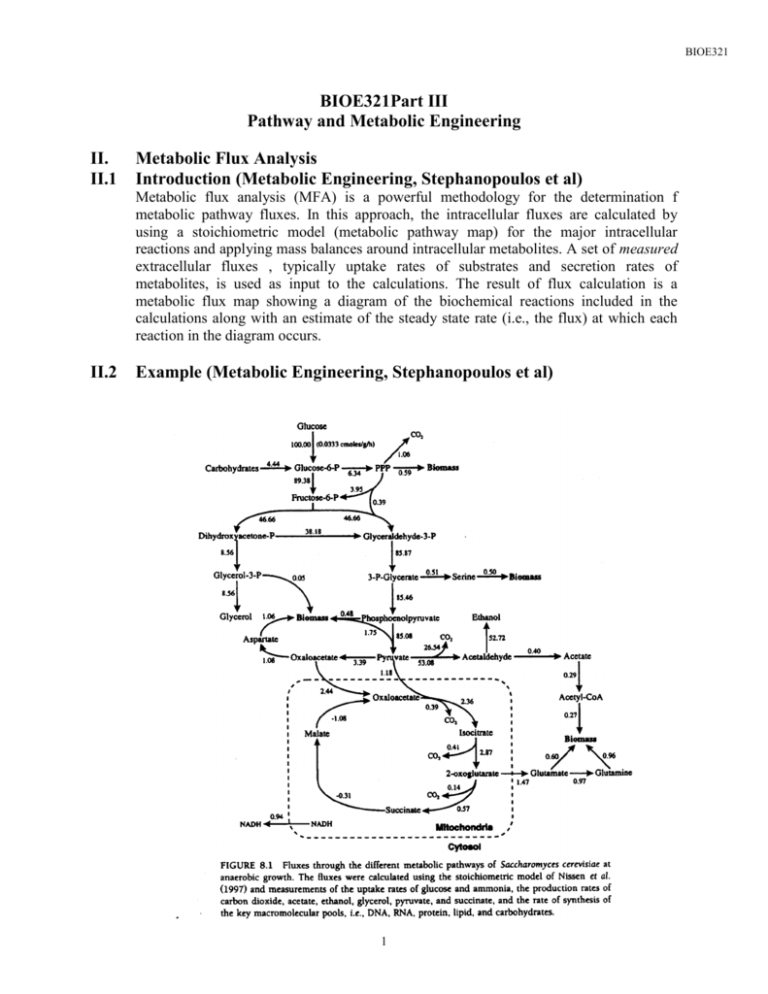
BIOE321 BIOE321Part III Pathway and Metabolic Engineering II. II.1 Metabolic Flux Analysis Introduction (Metabolic Engineering, Stephanopoulos et al) Metabolic flux analysis (MFA) is a powerful methodology for the determination f metabolic pathway fluxes. In this approach, the intracellular fluxes are calculated by using a stoichiometric model (metabolic pathway map) for the major intracellular reactions and applying mass balances around intracellular metabolites. A set of measured extracellular fluxes , typically uptake rates of substrates and secretion rates of metabolites, is used as input to the calculations. The result of flux calculation is a metabolic flux map showing a diagram of the biochemical reactions included in the calculations along with an estimate of the steady state rate (i.e., the flux) at which each reaction in the diagram occurs. II.2 Example (Metabolic Engineering, Stephanopoulos et al) 1 BIOE321 II.3 Other Applications of MFA (Metabolic Engineering, Stephanopoulos et al) 2 BIOE321 II.3 Concept of reaction stoichiometry Example 1 Consider a simple reaction network occurring in a constant volume cell shown in the following diagram So r0 S r1 r2 B A r3 r4 C D 3 BIOE321 in the above reaction network, S0 is changed into S (this may consider as the intake of substrate from outside of the cell), S is converted to A and B through reaction r1 and r2, A is converted to C by reaction r3, and B is converted to D through reaction r4. Notice that in general the reaction does not contain the stoichiometric information. It is usually accompanied by a set of biochemical reactions, whose stoichiometric relationships have already established. For example, Glucose + PEP -> Glucose-6-P + pyruvate or pyruvate + NADH -> lactate + NAD+ or Glucose-6-P + ATP -> 2 Glyceraldehyde 3-P + ADP Referring back to our previous example, suppose the reaction network follows the following reactions Referring back to our current example, suppose the reaction network follows the following reactions Reaction 0 : 0 S So r Reaction 1 : r1 A S 2 B S r Reaction 2 : 3 C A r 4 D B r Reaction 3 : Reaction 4 : Material Balance on the four species So, S, A, B and P, we have dSo dt dS dt dA dt dB dt dC dt dD dt ro ro r1 r1 r3 r3 r4 r3 r4 r2 4 BIOE321 where ri is the reaction rate in proper units (such as mM/g-cell-hr). Or in a compact form we have SO S d A dt B C D 0 0 0 1 0 rO 1 1 1 0 0 r1 1 0 1 0 0 r2 0 0 1 0 1 r 3 0 0 0 1 0 r4 0 0 0 1 0 or d ~ x dt ~ G T v~ where ~ x SO S A B C D ~ GT 0 0 0 1 0 1 1 1 0 0 1 0 1 0 0 0 1 0 1 0 0 0 0 1 0 0 0 0 1 0 v~ rO r 1 r2 r3 r4 x is commonly known as the state vector, which contains the state variables (in this case the concentration of each of the species), GT is the stoichiometric matrix, and v is the reaction rector. Note: the transpose of G is used as a symbol here because in some textbooks the state and reaction vectors are a row vectors rather than a column vectors. Question 1: The above formulation assumes the cell volume is constant, what should be done if this assumption is to be removed? Or under what condition this assumption is valid? Question 2: how will the formulation of the problem change if 1 0.2 A Reaction 1 : S r 2 0.5B Reaction 2 : S r 5 BIOE321 Example 2 Consider another reaction network shown in the following schematic diagram So r0 S r1 A r2 r3 r4 B P in the above reaction network, S0 is changed into S (this may consider as the intake of substrate from outside of the cell), S is converted to A and B through reaction r1 and r2, A is also converted to B by reaction r3, finally, P is being formed from B through reaction r4. Notice that as in the previous case, in general the reaction does not contain the stoichiometric information. It is usually accompanied by a set of biochemical reactions, whose stoichiometric relationships have already established. For example, Glucose + PEP -> Glucose-6-P + pyruvate or pyruvate + NADH -> lactate + NAD+ or Glucose-6-P + ATP -> 2 Glyceraldehyde 3-P + ADP Referring back to our current example, suppose the reaction network follows the following reactions 6 BIOE321 Reaction 0 : 0 S So r Reaction 1 : 1 0.5 A S r 2 0.6B S r Reaction 2 : 3 0.8B A r 4 0.7 P B r Reaction 3 : Reaction 4 : Material Balance on the four species So, S, A, B and P, we have dSo dt dS dt dA dt dB dt dP dt ro ro r1 r2 0.5r1 0.6r2 0.8r3 r3 r4 0.7r4 where ri is the reaction rate in proper units. Or in a compact form we have SO S d A dt B P 0 0 0 rO 1 0 1 1 1 0 0 r1 0 0.5 0 1 0 r2 0 0.6 0.8 1 r3 0 0 0 0 0 .07 r4 or d ~ x dt ~ G T v~ where 7 BIOE321 ~ x SO S A B P ~ GT 0 0 0 1 0 1 1 1 0 0 0 0.5 0 1 0 0 0.6 0.8 1 0 0 0 0 0 .07 v~ rO r 1 r2 r3 r4 x is commonly known as the state vector, which contains the state variables (in this case the concentration of each of the species), GT is the stoichiometric matrix, and v is the reaction rector. Note: the transpose of G is used as a symbol here because in some textbooks the state and reaction vectors are a row vectors rather than a column vectors. II.4 Concept of pseudo-steady state hypothesis (PSSH) on intracellular intermediates It is generally accepted that there is very high turnover of the pools of most metabolites. As a result, the concentrations of the different metabolite pools rapidly adjust to new levels, even after large perturbations in the environment experienced by the cell. It is therefore reasonable to assume that the pathway metabolites are at a pseudo-steady state. Note: the pseudo-steady state assumption does not implies the metabolite concentrates are at a fixed steady state, it is just that the rate of change of these metabolites are so fast that they can adjust to new state steady very rapidly. Example 1 of II.3 In this example, S, A and B are the intracellular metabolites, and So, C and D are the extracellular metabolites. Apply PSSH to S, A and B, we have SO S d A dt B C D dS o / dt 0 0 0 dCdt dD / dt 0 0 0 1 0 rO 1 1 1 0 0 r1 1 0 1 0 0 r2 0 1 0 1 0 r3 0 0 0 1 0 r4 0 0 0 1 0 or we have 8 BIOE321 rO SO 1 0 0 0 0 r1 1 0 0 rO d C 0 0 0 1 0 r2 0 1 0 r3 dt D 0 0 0 0 1 r3 0 0 1 r4 r4 and rO 0 r1 0 1 1 1 0 0 0 1 0 1 0 r2 1 0 1 r3 0 0 0 r4 We have a combination of algebraic and ODEs. Example 2 of II.3 In this example, S, A and B are the intracellular metabolites, and So, P is the extracellular metabolites. Apply PSSH to S, A and B, we have 0 0 0 rO dS O / dt 1 0 0 1 1 1 0 0 r1 0 0 0.5 0 1 0 r2 0 0.6 0.8 1 r3 0 0 dP / dt 0 0 0 0 .07 r4 Or dS O / dt dP / dt 1 0 rO 0 0.7 r 4 and 9 BIOE321 0 0 1 1 1 0 0 0 0.5 0 1 0 0 0 0 0.6 0.8 1 II.5 rO r 1 r2 r3 r4 Application of MFA – estimation of intracellular metabolic flux from extracellular metabolite rate As mention in section II.1, one of the potential application of MFA is to estimate intracellular metabolic rate. These intracellular metabolic rates are very difficult to measure. However, by making use of MFA, it is possible to estimate these intracellular fluxes based on some measurable quantities, in particular, the rate of formation of extracellular metabolites. Examples from previous sections will be used to illustrate the concepts. Recall from II.4 example 1, we have SO d C dt D rO 1 0 0 0 0 r1 0 0 0 1 0 r 2 0 0 0 0 1 r3 r4 1 0 0 rO 0 1 0 r 3 0 0 1 r4 and 0 0 0 rO 0 r1 1 1 1 0 0 1 0 1 0 r2 1 0 1 r3 0 0 r4 (*) Problem statement: Estimate the intracellular fluxes, r1, and r2. Note 1. ro is the substrate uptake rate, r3 and r4 are the rates of formation of extracellular product C and D, respectively. 10 BIOE321 2. Equation (*) has three equations and five unknowns. Therefore, measurements from only two out of the three extracellular fluxes are required to determine the unknown intracellular fluxes, r1 and r2. Case 1: Measurements: the rates of formation of C and D Since r3 and r4 are measured, we can rearrange (*) as 0 0 0 rO 1 1 1 0 0 r1 0 1 0 1 0 r 2 0 0 1 0 1 r3 r4 1 1 1 rO 0 1 0 r 1 0 0 1 r2 (*) 0 0 1 0 r3 r4 0 1 Therefore rO r 1 r2 1 1 1 0 1 0 1 0 0 1 1 1 0 1 0 0 0 1 1 0 0 1 0 r3 r4 0 1 0 0 1 0 r3 r 0 1 4 1 1 1 0 r3 r 0 1 4 r3 r4 r 3 r4 The above solution can be easily obtained by solving (*) without using matrix inversion. However, the use of matrix inversion will be the method of choice when the stoichiometric matrix is more complex. Case 1: Measurements: the rate of substrate uptake and the rate of formation of D Since ro and r4 are measured, we can rearrange (*) as 11 BIOE321 0 0 0 rO 0 r1 1 1 1 0 0 1 0 1 0 r2 1 0 1 r3 0 0 r4 1 1 0 r1 1 0 1 r2 1 0 r3 0 (*) 1 0 0 0 ro r4 0 1 Therefore r1 r 2 r3 1 1 1 0 1 0 r 1 0 1 0 0 o r 1 0 0 1 4 0 1 0 1 1 0 r 0 0 1 0 0 o r4 1 1 1 0 1 1 1 0 1 ro r4 1 1 ro r4 r 4 ro r4 Again, the above solution can be easily obtained by solving (*) without using matrix inversion. However, the use of matrix inversion will be the method of choice when the stoichiometric matrix is more complex. Question: what will you do when all three extracellular rates are available, i.e., how are you going to make use of the extra measurement? 12 BIOE321 More Example – choice of measurements Consider the following (Stephanopoulos et al, 1998). reaction network given in Metabolic rpyr rlac rc rfor rac ret Apply PSSH on the intermediate pyruvate (PYR), NADH, AcCoA, we have dPYR dt 0 rpyr rlac rc r for dAcCoA dt dNADH dt 0 rc r for 0 rpyr rlac rac 13 ret rc 2ret Engineering BIOE321 or 0 0 1 1 1 1 0 0 0 0 1 1 1 1 0 0 2 0 1 1 1 rpyr r lac rc r for rac ret Case 1: suppose we measure rpyr, rlac, and rfor, we have 0 0 0 1 1 1 rpyr 0 0 1 rlac 1 1 0 r for 0 1 0 1 1 1 0 2 1 rc r ac ret Solving for the other unknown rates, we have rc r ac ret 1 0 1 1 1 rpyr 1 0 1 1 1 0 0 1 rlac 0 2 1 1 0 r for 1 1 1 1 rpyr 0 0 0.5 rlac 1 1 0.5 r for Therefore, the three unknown fluxes, rc, rac, ret can be calculated from the measured fluxes rpyr, rlac and rfor. Case 2: suppose we measure rpyr, rac, and ret, we have 0 0 0 1 1 0 rpyr 0 1 1 r for 0 rac 1 0 1 1 0 0 1 1 1 1 2 14 rlac r c ret BIOE321 Note, in order to solve the three known fluxes rlac, rc and ret from rpyr, rfor and rac, we need to invert the following matrix 1 1 0 0 1 1 1 1 2 However, the rank of the above matrix is only 2, i.e., the above matrix is singular and cannot be inverted. This example shows the importance of the choice of measurements. 15
